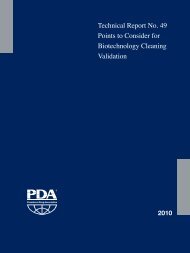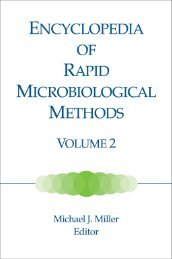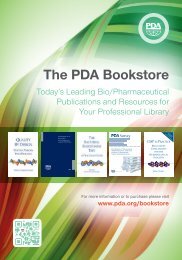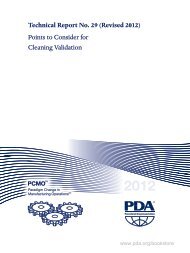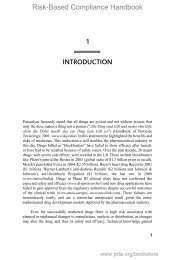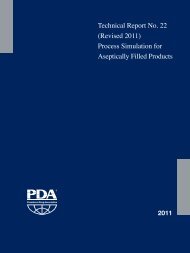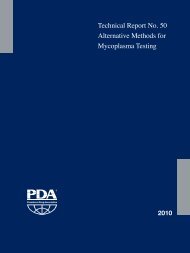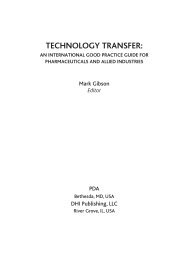Technical Report No. 48 Moist Heat Sterilizer Systems: Design ...
Technical Report No. 48 Moist Heat Sterilizer Systems: Design ...
Technical Report No. 48 Moist Heat Sterilizer Systems: Design ...
- No tags were found...
Create successful ePaper yourself
Turn your PDF publications into a flip-book with our unique Google optimized e-Paper software.
Table of Contents1.0 Introduction ...................................................41.1 Purpose / Scope ............................................... 42.0 Glossary of Terms .........................................73.0 Sterilization Processes ..............................123.1 Saturated Steam Processes ............................ 123.1.1 Gravity Displacement Process ................. 133.1.2 Pre-Vacuum Process ................................ 133.2 Air Overpressure Processes ........................... 143.2.1 Steam Air Mixture Process andSuperheated Water Process .................... 143.3 Decontamination Processes ........................... 153.4 GMP and <strong>No</strong>n-GMP <strong>Sterilizer</strong>s ........................ 164.0 Comprehensive <strong>Sterilizer</strong>System <strong>Design</strong> ................................................184.1 User Requirements Specifications .................. 194.1.1 Equipment Location, Installation, andMaintenance Access Considerations....... 194.1.2 Assessing Process Requirements ............ 224.2 System Control ............................................... 234.3 Functional Requirements Specifications ......... 244.4 Detailed <strong>Design</strong> Specification ......................... 255.0 EQUIPMENT VERIFICATION& QUALIFICATION ..............................................265.1 Commissioning ............................................... 265.1.1 Factory Acceptance Testing .................... 275.1.1.1 Leveraging the FAT ............................. 285.1.1.2 Software Tests ................................... 295.1.2 Site Acceptance Testing ........................... 295.2 Qualification ................................................... 305.2.1 Static Equipment Qualification or IQ ........ 305.2.1.1 Steam Quality Testing ......................... 305.2.1.1.1 Prerequisites to Physical,Chemical and EndotoxinTesting of Pure Steam .................. 305.2.1.1.2 Physical, Chemical andEndotoxin Testing ........................ 315.2.2 Dynamic Equipment Qualification or OQ .. 315.2.2.1 Empty ChamberTemperature Distribution .................... 316.0 Cycle Development .......................................326.1 Preliminary System Testing ............................. 326.2 Thermal Measurement Test Equipment .......... 326.3 Sterilization Cycle Optimization ....................... 336.3.2 Pressure Vacuum (Pre-vacuum)Cycle Development .................................. 427.0 On-Going Control .........................................437.1 <strong>Sterilizer</strong> System Maintenance ....................... 437.2 Calibration ...................................................... 447.2.1 Calibration Records .................................. 458.0 Documentation .............................................469.0 Appendix ..........................................................47Appendix A: <strong>Design</strong> Considerations ..................... 47Appendix B: <strong>Sterilizer</strong> Verification Activities ......... 58Appendix C: Documentation ................................. 6210.0 References .....................................................63www.pda.org/bookstore
Figures and Tables IndexFigure 1.1-1Table 3.3-1Figure 3.3-1Table 3.4-1Table 4.0-1Figure 4.1.1-1Figure 4.1.1-2Figure 4.1.1-3Figure 5.1.1-1Figure 6.3-1Figure 6.3-2validation Life-CycleActivities ................................. 6BioSafety Levels and<strong>Sterilizer</strong> Requirements ........ 15Decontamination andStandard Steam FlowCycle Comparison ................. 16GMP and <strong>No</strong>n-GMPComparison Chart ................. 17<strong>Design</strong> QualificationExample ................................ 18Facility <strong>Design</strong>Example One ......................... 20Example of DualWall Seals ............................. 21Example of WallSeal Facility <strong>Design</strong> .............. 21<strong>Sterilizer</strong> Manufactureand Testing ............................ 28example of <strong>Heat</strong>ing UniformityProblem During InitialDevelopment Study ............... 34example of <strong>Heat</strong>ing UniformityProgression During CycleDevelopment Study ............... 34Figure 6.3-3 example of <strong>Heat</strong>ing UniformityProgression During CycleDevelopment Study ............... 35Table 6.3-1 Cycle OptimizationConsiderations Table............. 36Figure A-1 example of <strong>Sterilizer</strong>Chamber ................................ 47Figure A-2 example of Sliding Door ....... 49Figure A-3 example of Swing Door ........ 49Figure A-4 example of ActiveDoor Gasket .......................... 50Figure A-5 example of Inlet Air Filter ..... 52Figure A-6 example of Typical LiquidRing Vacuum Pump ............... 52Figure A-7 example of <strong>Sterilizer</strong> ControlPanel with HMI ..................... 53Figure A-8 example of ElectricSteam Generator ................... 55Figure A-9 example of AirDifferential Seal .................... 57Figure A-10 example of BiologicalSafety Seal ............................ 57Figure C-1 Documentation ...................... 62www.pda.org/bookstore
• Equipment Operation, including calibration and maintenance• Equipment Qualification, which may include Factory Acceptance Testing (FAT), Site AcceptanceTesting (SAT), and commissioning• On-going control requirements• Cycle DevelopmentThis <strong>Technical</strong> <strong>Report</strong> will not address, and considers outside the scope of its content, steam-inplace,which will be covered in a subsequent PDA technical report. Several aspects described withinthis document may be useful for consideration when developing these types of systems; howeverthe content of the <strong>Technical</strong> <strong>Report</strong> has been prepared specifically for moist heat sterilizers. A lifecycleapproach is recommended for the specification, design, testing and qualification of moist heatsterilizer systems, and the reader should consult <strong>Technical</strong> <strong>Report</strong> <strong>No</strong>. 1 in this regard. (1)The sterilizer life cycle approach to validation activities (see Figure 1.1-1) should include a ChangeControl Program and a Quality Risk Management (QRM) Program. A Change Control Programwould encompass the requirements for documenting and verifying all changes made to the sterilizerthat would affect its validated state. The QRM program would provide the end-user with the toolsrequired to make intelligent risk-based decisions with respect to the design of the sterilizer, thesterilization process itself, and the operation of the sterilizer. QRM may be used during qualificationand validation to prioritize and develop test requirements and acceptance criteria, and may also beused in conjunction with Change Control to determine the appropriate requalification interval forthe sterilizer. PDA <strong>Technical</strong> <strong>Report</strong> <strong>No</strong>. 44: Quality Risk Management for Aseptic Processes outlines anapproach that can be adopted. (2)Points to consider for equipment qualification activities are provided in this report. However, when toconduct these activities and the personnel who will perform them is determined by the user. Activityoverlap or gaps should be avoided where possible. Personnel performing these activities should havethe suitable skills and qualifications commensurate to their assigned responsibilities.www.pda.org/bookstore<strong>Technical</strong> <strong>Report</strong> <strong>No</strong>. <strong>48</strong>© 2010 Parenteral Drug Association, Inc.5



